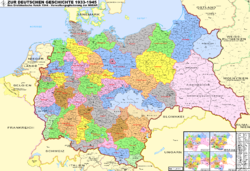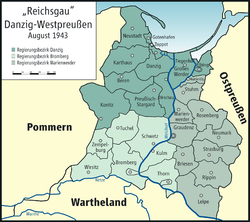- Reichsgau Danzig-West Prussia
-
Reichsgau Danzig-Westpreußen
Reichsgau Danzig-West PrussiaGau of Nazi Germany ← 
←
←
←
1939–1945  →
→

Flag Coat of arms Map of Nazi Germany showing its administrative subdivisions, the Gaue and Reichsgaue Capital Danzig Gauleiter - 1939 - 1945 Albert Forster History - Establishment 1939 - Disestablishment 1945 The Reichsgau Danzig-West Prussia (German: Reichsgau Danzig-Westpreussen) was a Nazi German province created on 8 October 1939 from the territory of the annexed Free City of Danzig, the annexed Polish province Greater Pomeranian Voivodship (Polish Corridor), and the Nazi German Regierungsbezirk West Prussia of Gau East Prussia. Before 2 November 1939, the Reichsgau was called Reichsgau West Prussia.[1] Though the name resembled the pre-1920 Prussian province West Prussia, the territory was not identical. In contrast to the former Prussian province, the Reichsgau comprised the Bromberg (Bydgoszcz) region in the South and lacked the Deutsch-Krone (Walcz) region in the West.
The capital of the province was Danzig (Gdańsk) and its population without the city was 1,487,452 (in 1939). The area of the province was 26,056 km², 21,237 km² of which was annexed Danzig and Pomerelian territory.[1]
Contents
History
Further information: History of Pomerania (1933-1945)The Prussian province West Prussia was dissolved in 1920, following the Treaty of Versailles. The bulk of it became part of the newly established Second Republic of Poland and was administered as Pomeranian Voivodship (Polish Corridor). The eastern remains of German West Prussia were attached to the Province of East Prussia as Regierungsbezirk West Prussia - a Regierungsbezirk ("government region") being a German administrative subunit of a province (Provinz) comprising several counties (Kreise). The western remains of German West Prussia were merged to the German remains of the former Province of Posen and made a new province, Posen-West Prussia.
After the Nazis came to power in Germany, they reformed the administrative system by transforming the former German provinces and states into their Gau system in 1935 as a part of their Gleichschaltung policy.
In 1938, German Posen-West Prussia was dissolved and its former West Prussian territory was attached to the German Pomeranian Gau. Also in 1938, the Polish Pomeranian Voivodship was expanded southward to comprise the Bydgoszcz (Bromberg) region. This region (former Netze District) had during Prussian times been administered as Regierungsbezirk Bromberg of the Province of Posen. The resulting enlarged Pomeranian voivodship was called Greater Pomeranian Voivodship (Wielkopomorskie).
When Nazi Germany invaded Poland in September 1939, this Greater Pomeranian voivodship was first made the German military district "West Prussia",[2] and by a decree[3] of Adolf Hitler on October 8 merged with the Free City of Danzig and the East Prussian Regierungsbezirk West Prussia, to form the Reichsgau West Prussia.[4] The western remains remained outside and continued to be administered by the German Pomeranian Gau as Regierungsbezirk Grenzmark Posen-West Prussia according to the 1938 reform, while the Bromberg (Bydogoszcz) region stayed with Reichsgau West Prussia and was not attached to Reichsgau Posen, the later "Warthegau". The designation Reichsgau instead of just Gau indicates that the province primarily consisted of annexed territory. A Gauleiter of a Reichsgau was also titled Reichsstatthalter. Other Reichsgaue were e.g. Reichsgau Wartheland and Reichsgau Sudetenland.
In March 1945 the region was captured by the Red Army, and The Nazi governor, Albert Forster, was later sentenced to death and executed for crimes against humanity. The German population either fled or was expelled.
Administration
Danzig-West Prussia was divided into three government regions (Regierungsbezirk), with the name-giving capitol cities of Bromberg, Danzig and Marienwerder.[4]
Extermination and expulsion of Poles and Jews by Nazi Germany
Nazi German policy aimed at extermination of Jewish and Polish population. Mass murder sites in the region include:
- Stutthof concentration camp, where over 85,000 died(mostly Poles).
- Piaśnica, site of mass murder of around 12,000 local Polish-Kashub intelligentsia and other people.[5]
The Polish Roman Catholic Church was severely persecuted and most Catholic priests were deported to concentration camps.
An organisation called Selbstschutz was formed out of local Germans who hunted down prominent members of Polish and Jewish community and mass murdered them. In West Prussia , Selbstschutz under the command of Ludolf von Alvensleben were 17,667 men strong, and had already executed 4,247 Poles by October. Soon a series of Selbstschutz camps were established in the region[6]
The total number of victims of Selbstschutz mass murder campaign is difficult to determine in precise way.[6] In autumn 1939 Oebsger-Roder lamented that that despite all the measures only a fraction of Poles were destroyed and gave the number of 20,000.[6]
Jews did not figure prominently among the victims in West Prussia, as the area was not densely populated by them and most had fled before Germans arrived. However in places where they stayed they were removed by expulsion and what was classified as “other measures”-in effect meaning murder. In areas where Jewish families or individuals remained a “shameful situation” was proclaimed, and authorities expected the Selbstschutz to remedy it through direct action.[6] One Selbstschutz commander, Wilhelm Richardt, said in Karolewo (Karlhof) camp that he did not want to build big camps for Poles and feed them, and that it was an honour for Poles to fertilize the German soil with their corpses.[6] There was little opposition or lack of enthusiasm for activities of Selbstschutz among those involved in the action.[6] There was even a case where a Selbstschutz commander was relieved after he failed to account for all the Poles that were required, and it was found that he executed "only" 300 Poles[6]
Additionally Germans expelled a number of Poles and Jews-the overall number of the German ethnic cleansing is estimated by the Stutthof Museum at 120-170.000 [7] and located German colonists in their place.
See also
- Administration of Danzig-West Prussia 1939-1945
- World War II evacuation and expulsion
- Polish areas annexed by Nazi Germany
References
- ^ a b Piotr Eberhardt, Jan Owsinski, Ethnic Groups and Population Changes in Twentieth-century Central-Eastern Europe: History, Data, Analysis, M.E. Sharpe, 2003, p.170, ISBN 0-7656-0665-8
- ^ Andreas Toppe, Militär und Kriegsvölkerrecht: Rechtsnorm, Fachdiskurs und Kriegspraxis in Deutschland 1899-1940, Oldenbourg Wissenschaftsverlag, 2008, p.398, ISBN 3-486-58206-2
- ^ "Erlaß des Führers und Reichskanzlers über die Gliederung und Verwaltung der Ostgebiete"
- ^ a b Andreas Toppe, Militär und Kriegsvölkerrecht: Rechtsnorm, Fachdiskurs und Kriegspraxis in Deutschland 1899-1940, Oldenbourg Wissenschaftsverlag, 2008, p.399, ISBN 3-486-58206-2
- ^ Ludobójstwo w Piaśnicy jesienią 1939 r. ze szczególnym uwzględnieniem losu mieszkańców Gdyni Elżbieta Maria Grot custodian of Stutthof State Museum [1]
- ^ a b c d e f g The Origins of the Final Solution Christopher R. Browning, Jürgen Matthäus pages 31-34, University of Nebraska Press, 2007
- ^ WYSIEDLENIA Z ZIEM ZACHODNICH RZECZYPOSPOLITEJ W OKRESIE OKUPACJI NIEMIECKIEJ doctor Andrzej Gąsiorowski Stutthof Museum [2]
Sources
- Shoa.de - List of Gaue and Gauleiter (in German)
- Die NS Gaue (in German) Deutsches Historisches Museum website
- Die Gaue der NSDAP (in German)
 Administrative divisions of Nazi Germany
Administrative divisions of Nazi GermanyGaue Gau Baden · Gau Bayreuth · Gau Berlin · Gau Düsseldorf · Gau Essen · Gau Franken · Gau Halle-Merseburg · Gau Hamburg · Gau Hessen-Nassau · Gau Köln-Aachen · Gau Kurhessen · Gau Magdeburg-Anhalt · Gau Mainfranken · Gau Mark Brandenburg · Gau Mecklenburg · Gau Moselland · Gau München-Oberbayern · Gau Niederschlesien · Gau Oberschlesien · Gau Ost-Hannover · Gau Ostpreußen · Gau Pommern · Gau Sachsen · Gau Schleswig-Holstein · Gau Schwaben · Gau Südhannover-Braunschweig · Gau Thüringen · Gau Weser-Ems · Gau Westfalen-Nord · Gau Westfalen-Süd · Gau Westmark · Gau Württemberg-HohenzollernReichsgaue Reichsgau Danzig - Westpreußen · Reichsgau Flandern · Reichsgau Kärnten · Reichsgau Niederdonau · Reichsgau Oberdonau · Reichsgau Salzburg · Reichsgau Steiermark · Reichsgau Sudetenland · Reichsgau Tirol-Vorarlberg · Reichsgau Wallonien · Reichsgau Wartheland · Reichsgau WienOperational zones Autonomous regions Other districts Related topics: Gauleiter · List of Gauleiters Categories:- States and territories established in 1939
- States and territories disestablished in 1945
- World War II occupied territories
- Nazi Gaue
- History of Gdańsk
- West Prussia
Wikimedia Foundation. 2010.


